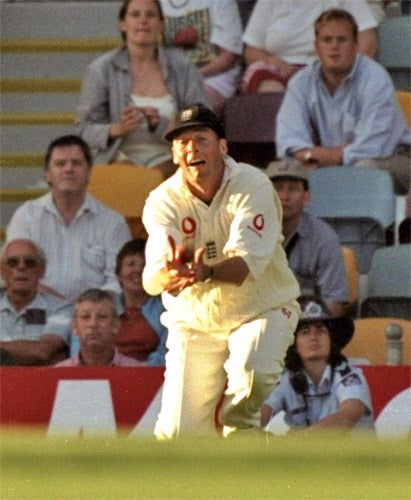Angus Fraser: My errors and others' excellence taught me the value of good fielding

Support truly
independent journalism
Our mission is to deliver unbiased, fact-based reporting that holds power to account and exposes the truth.
Whether $5 or $50, every contribution counts.
Support us to deliver journalism without an agenda.

Louise Thomas
Editor
The quality and intensity of the fielding of a team tells you where it is at. It gives onlookers an insight into the togetherness, commitment and spirit of a side.
Good teams are vibrant, energetic and athletic in the field. They focus on their job and like an anaconda they constrict their prey, squeezing the life out of it by ruthlessly exploiting every mistake it makes.
Poor teams are the opposite. They tend to be lethargic, lonely and lost. They drift aimlessly around a field like lost goats that are solely interested in themselves. When a wicket falls they force themselves to join their team-mates, it is not instinctive.
Cricketers do not get picked for their fielding. Yes, it can make the difference when a captain has to pick between two players when they are vying for the same spot but seldom, if ever, will the skill be deemed more important than the runs or wickets a player potentially offers. Because of this fielding is something that a player gives to his side for nothing, a way to show commitment to the cause. This is why good teams tend to be very good fielding sides.
There are many aspects to fielding and each is equally important. You don't have to be an outstanding athlete to take catches in the slips but you do need lightning reflexes and the ability to concentrate. In the covers you need to be quick, lithe and athletic with a fast and accurate throw. In the deep, where fast bowlers tend to graze, there is a bit more room for manoeuvre but you still need to be fast, a good catcher and to have a powerful, accurate throw.
I have played in good and bad fielding sides. No doubt there have been occasions when my fielding has highlighted the excellence or shortcomings of teams I represented. I am totally aware of the difference fielding can make.
I will never forget the valuable role Mark Ramprakash played on my return to Test cricket in 1993. After more than two years out injured I came back for the final Ashes Test at The Oval. In one of my early overs I bowled a half-volley to Mark Waugh, who smashed it into the covers. Ramprakash made an excellent diving stop to prevent a run being taken. I dismissed Waugh with the next ball, caught behind, and was off. If Ramprakash had not stopped the ball the wicket of Waugh would not have followed.
The reverse side came in Brisbane in 1998 and I was the guilty party. I was busy arguing with a section of the crowd that was abusing me at third man when an Ian Healy flick to leg came flying towards me. With my mind not fully focused I grassed the catch, much to the amusement of those I had been barracking. Healy scored a hundred.
England's fielding at Trent Bridge against Pakistan was magnificent. The catching was superb and there was energy about everything they did. It suggested a real togetherness about the side. When wickets are being taken regularly it is easy for a side to maintain such enthusiasm, the real test comes when the opposition are 270 for two, and this will happen. At the moment however the signs are good, very good.
Subscribe to Independent Premium to bookmark this article
Want to bookmark your favourite articles and stories to read or reference later? Start your Independent Premium subscription today.
Join our commenting forum
Join thought-provoking conversations, follow other Independent readers and see their replies
Comments